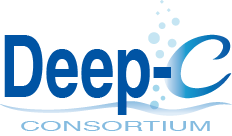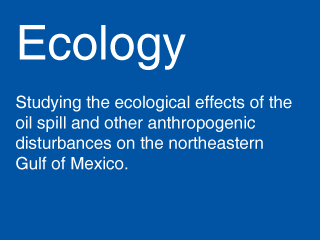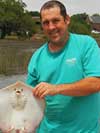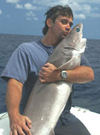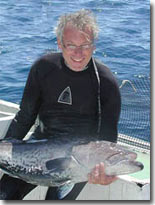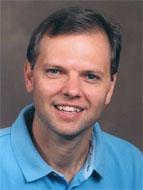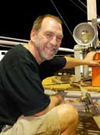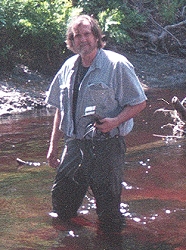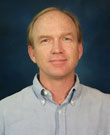The Ecological Pathways

The deep seabed of the Gulf of Mexico
is home to cold communities of clams,
mussels and tube worms (shown above).
The ecology of the slope and shelf edge in the Florida Panhandle Bight is poorly known and woefully understudied (Schroeder and Woods, 2000) compared to the central and western Gulf (Rowe and Kennicutt II, 2009) where oil and gas extraction predominates. While it is clear that the Deepwater Horizon (DwH) oil spill and the use of dispersants in an effort to quell the spill can have profound effects on the living organisms in the water column, deep sea, slope, and shelf-edge, reverberating throughout the trophic system, the magnitude of this effect and its consequences for ecological processes remain ill-defined.
The objectives of Deep-C ecology researchers are to: (1) to define and quantify the diversity of biological responses to the dynamic physical and chemical properties of the environment, (2) to evaluate the impact of discharged and background hydrocarbons on community structure and function, and (3) to inform the development of both food web and earth system models.
Studies are being conducted across trophic levels that include pelagic phytoplankton, pelagic and benthic microbial communities, meiofaunal, macrofaunal, and fish assemblages, from both organismal and ecological approaches. Six projects already underway provided sampling that extends from the shore to the deep sea (see figure below), collecting hydrographic, water chemistry, and biological data at all taxonomic levels. Results from this work document the influence of coastal and riverine waters offshore, the influence of deep sea waters on the shelf (caused by upwelling through the De Soto Canyon), and the presence of hypoxic areas at mid-shelf sites. These results also reveal trace levels of polycyclic aromatic hydrocarbons (PAHs) across the shelf, the source of which is currently unknown.
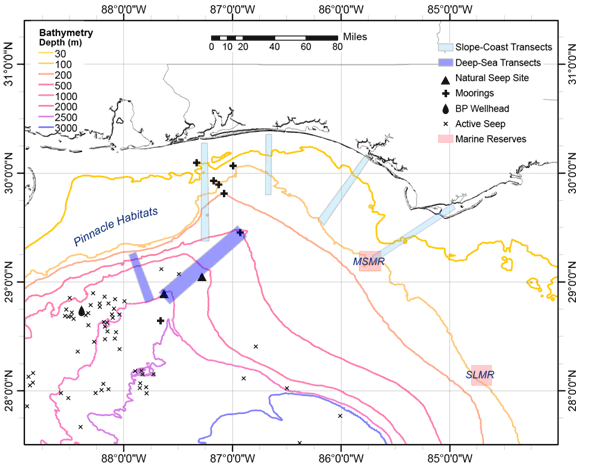
The study area for the "Deep Sea to Coast Connectivity in the Eastern Gulf of Mexico" Consortium encompasses the Florida Panhandle Bight. The rectangles represent proposed study areas: MSMR, Madison Swanson Marine Reserve; and SLMR, Steamboat Lumps Marine Reserve. Oil sources shown are the BP wellhead and the active natural seeps.
Both historical and newly-derived empirical data are being used to develop a food web model that links trophic interactions with hydrodynamic and biogeochemical data in order to define the drivers and spatial and temporal patterns of productivity. It is anticipated that the analyses of planktonic and benthic community responses over time will make significant contributions to our understanding of the severity and longevity of the oil spill, demonstrating the cumulative effect on mid- to upper-trophic level responses and resilience of the system.
Primary Productivity - Phytoplankton and microbes form the base of the trophic web, providing direct and indirect carbon transfer at the nexus of primary and microbial-loop production. Microbial plankton are typically limited by phytoplankton production, but allocthonous organic matter from terrestrial sources or the input of oil and dispersants can dramatically shift the balance of energy flow in the microbial loop and fundamentally change basic trophic interactions among lower trophic levels. Sedimentation of oil and detritus from the water columns provides an archival record of chemical constituency, environmental conditions, and biological effects of pre-spill, spill, and post-spill conditions (including evidence of recovery), which appear in progressively shallower core-depth intervals. Important primary producers in the Gulf of Mexico are photosynthesizing protists, including pelagic diatoms and nanoplankton. Their presence in sediments are particularly useful because they leave sedimentary records that extend from the present to far back in geologic time, enabling us to identify abrupt, large-scale changes in living populations and extreme environmental events. The nanoplankton response to the escalator effect of the De Soto Canyon is near-shore nanoplankton assemblages that mimic those of the open ocean, while the riverine influence causes riverine-like assemblages to become dominant on the shelf. The mixing of these water masses is an unknown, but provides a likely driver of production on the shelf, making the integration of physical and chemical tasks of the consortium with the biological characterizations key to understanding the productivity of the system and its resiliency to perturbation. Protists — phytoplankton, microzooplankton, and foraminifera — can be used as tracers to identify prevailing current flow year-round within the Deep-C study area. The objectives of this research, therefore, are (1) to quantitatively compare the historic (Pariente 1997) and current distributions of nanoplankton and microzooplankton within the photic zone of the study area and within the sediments in order to assess the relationship between the floras in the overlying water column and the sedimentary record; and (2) to determine the ecological responses of protists under varying environmental conditions (natural to anthropogenic events, including current Mississippi River flooding conditions).
Microbial Component - Deep-C ecology researchers are examining the effects of oil and settling algal blooms on critical biogeochemical processes catalyzed by sedimentary microorganism. Based on a combination of culture-based and cultivation-independent molecular approaches, researchers have observed that oil contamination from the DwH spill has a profound impact on the abundance and community composition of indigenous bacteria in Gulf sediments, and the evidence points to members of the Gammaproteobacteria (Alcanivorax, Marinobacter) and Alphaproteobacteria (Rhodobacteraceae) as key players in oil degradation there. The working hypothesis is that pulses of refractory (crude oil) and labile (phytoplankton cells) particulate organic matter change the permeabilities and biological mixing activities in the sediments across the shelf depth gradient and thereby the interfacial solute and particle transport that controls the sedimentary microbial community functions, degradation rates and redox zonation. It is hypothesized that parallel developments in microbial community response and biogeochemical reactions can be observed in sediments influenced by crude oil or/and phytoplankton particles but with distinct differences in the active species. Therefore, the team's research objectives are: (1) To quantify the spatial distribution and temporal changes of organic matter including petroleum hydrocarbons and algal material in sediments. (2) To determine the microbial community response to the deposition of refractory (petroleum hydrocarbons) and labile (plankton algae) organic matter sources as well as the synergistic effects caused by a combined deposition. (3) To quantify rates of benthic mineralization activity (oxygen consumption, dissolved inorganic and organic carbon production) and interfacial fluxes in sediments affected by oil and algae and relate them to parameters controlling transport of metabolites (permeability, macrofauna abundance).
Benthic Communities - Sediment-dwelling meiofauna (organisms ranging in size from 30 to 300μm, such as nematode worms and small crustaceans) and macrofauna (organisms > 300μm, such as polychaete worms and clams) that are short-lived and sensitive to pollution impacts make effective indicators of biologically-stressed systems (Hicks 1991). These organisms collectively provide important ecosystem services, including bioturbation – an engineering feat that modifies geochemical gradients and redistributes food resources from within sediments to the surface layers (Meysman et al. 2006). Any disruption of their activities can have a profound influence on trophic interactions. Indeed, benthic meiofauna and macrofauna form an integral component of the food web for benthic and demersal fish species, tying the benthic primary producers and bacterial communities to mid- and upper-trophic level organisms. Deep-C seeks to assess species abundance, richness, diversity, and community structure of meiofaunal and macrofaunal assemblages throughout the Florida Panhandle Bight. The primary question to be addressed in this research is, do these characteristics vary across depth strata, across seasons, and/or across topographic features? A second question of interest is, how does condition vary in response to natural hydrocarbon seeps?
Fisheries Species - Deep-C studies of the trophic interactions of fisheries species of the Florida Panhandle Bight are motivated by evidence that DwH oil reached the continental shelf from the deep sea via the De Soto Canyon, and by anecdotal evidence from fishermen and scientists that this event had a significant effect on fish health and community composition. Given the strong linkages between large-scale oceanographic features (e.g., the Loop Current), geomorphology (e.g., the De Soto Canyon, the Apalachicola River Delta), and fisheries productivity (Schroeder et al. 2000), the Deep-C Consortium has adopted an approach to evaluate post-spill impacts on the Gulf ecosystem that link results from the ecological research with those of the other Deep-C research areas. The goal is to survey fish assemblages to determine the level and effect of exposure to PAHs on fish health and characterize areas most likely affected by the spill. Deep-C ecology researchers seek to answer three general questions. (1) What are the spatial, temporal, and depth-mediated differences in the diversity, distribution, and abundance of fish assemblages in the deep sea, slope, and shelf edge of the region? (2) Are differences in exposure to PAHs correlated with any differences in fish health, based on age, size structure, and reproductive condition? (3) What are the physical and trophic linkages of this assemblage?
The Food Web Model - Data from Deep-C research will be integrated into a spatially-explicit three dimensional biogeochemical marine food web model, Atlantis, that contains sub-models for hydrographic processes, chemical and biological factors that influence primary productivity, food-web interactions among species, habitat availability, nutrient loading, biomagnification of pollutants, and other chemical and biophysical features crucial for ecosystem functioning, including climate effects. The model will be used to evaluate ecological, social, and economic questions relevant to the DwH oil spill and other extreme events that influence ecosystem health.
Sources:
Hicks, G. R. F.: 1991, 'Monitoring with Meiofauna: A Compelling Option for Evaluating Environmental Stress in Tidal Inlets', in: Coastal Engineering – Climate for Change, Auckland, New Zealand: 10th Australasian Conference on Coastal and Ocean Engineering, pp. 387391.
Meysman, F. J. R., J. J. Middelburg, and C. H. R. Heip. 2006. Bioturbation: a fresh look at Darwin's last idea. Trends in Ecology & Evolution 21:688-695.
Pariente, V. 1997. Coccolithophores of the Gulf of Mexico and their Relationship to Water-Column Properties. Ph. D. Dissertation. Texas A&M University, College Station.
Rowe, G. T. and M. C. Kennicutt II. 2009. Northern Gulf of Mexico continental slope habitats and benthic ecology study: Final report. OCS Study MMS 2009-039 U.S. Dept. of the Interior, Minerals Management. Service, Gulf of Mexico OCS Region.
Schroeder, W. W., C. F. Wood, and (eds). 2000. Physical/Biological Oceanographic Integration Workshop for the DeSoto Canyon and Adjacent Shelf October 19-21, 1999. OCS Study MMS 2000-074:168 pp. U. S. Department of the INterior, Minerals Management Service, Gulf of Mexico OCS Region, New Orleans, LA.
Schroeder, W. W. and C. F. Woods. 2000. Physical/Biological Oceanographic Integration Workshop for De Soto Canyon and Adjacent Shelf: October 19-21, 1999. OCS Study MMS 2000-074 U.S. Department of the Interior, Minerals Management Service, Gulf of Mexico OCS Region:168 pp.
Deep-C was a four-year, interdisciplinary study of deep sea to coast connectivity in the northeastern Gulf of Mexico.Deep-C is no longer an active research project. The information on this website is for historical reference purposes only.
Home | About Us | Research Areas | Data Center | News & Multimedia | Education & Outreach
© Deep-C Consortium. All Rights Reserved.
This research was made possible by a grant fromThe Gulf of Mexico Research Initiative (GoMRI).
Copyright | Disclaimer | Privacy Policy
